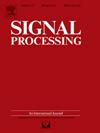设计最佳二维非冗余阵列
IF 3.4
2区 工程技术
Q2 ENGINEERING, ELECTRICAL & ELECTRONIC
引用次数: 0
摘要
阵列信号处理的最新进展主要集中在增强信号源检测和减少阵列元素之间相互耦合的影响上。通过稀疏阵列形成的虚拟阵列进行到达方向(DOA)估计,可以实现这一目标。非冗余阵列(NRA)是稀疏阵列中一种非常常见的结构。传统上,一维非冗余阵列只能捕捉信号源的方位角或仰角,但实际应用中往往需要同时捕捉这两个角度。本文介绍了设计二维(2-D)NRA 的优化方法,以满足这一需求。除了创建具有最小孔径的二维 NRA 的优化设计方法外,还提出了创建具有所需孔径、相互耦合效应最小以及两者混合的二维 NRA 的优化设计方法。所设计的阵列可以是矩形,也可以是边数为 4 倍的正多边形。所提出的阵列设计方法大大提高了设计 NRA 的灵活性,可以为任何所需数量的传感器创建各种阵列配置。仿真结果表明,所提出的阵列在估计信号源的 DOAs 方面优于现有的二维阵列,并且在抵御相互耦合影响方面表现出更强的鲁棒性。本文章由计算机程序翻译,如有差异,请以英文原文为准。
Design of optimum two-dimensional non-redundant arrays
Recent advancements in array signal processing focus on enhancing source detection and reducing the effects of mutual coupling among array elements. This has been achieved using Direction of Arrival (DOA) estimation via virtual arrays formed by sparse arrays. Non-Redundant Arrays (NRAs) are a very common structure among sparse arrays. Traditionally, one-dimensional NRAs capture either azimuth or elevation angles of sources, but practical scenarios often require both simultaneously. This paper introduces optimized methods for designing two-dimensional (2-D) NRAs to address this need. In addition to the optimized design approach for creating 2-D NRAs with minimum aperture, the optimized design approaches for creating 2-D NRAs with desired aperture, with minimized mutual coupling effect and with hybrid of both are proposed. The designed arrays can be in the form of a rectangle or a regular polygon with the number of sides being a multiple of 4. The proposed array design methods significantly enhance the flexibility in designing NRAs, allowing the creation of various array configurations for any desired number of sensors. Simulation results show that the proposed arrays outperform the existing 2-D arrays in estimating the DOAs of signal sources and show more robustness against the effects of mutual coupling.
求助全文
通过发布文献求助,成功后即可免费获取论文全文。
去求助
来源期刊

Signal Processing
工程技术-工程:电子与电气
CiteScore
9.20
自引率
9.10%
发文量
309
审稿时长
41 days
期刊介绍:
Signal Processing incorporates all aspects of the theory and practice of signal processing. It features original research work, tutorial and review articles, and accounts of practical developments. It is intended for a rapid dissemination of knowledge and experience to engineers and scientists working in the research, development or practical application of signal processing.
Subject areas covered by the journal include: Signal Theory; Stochastic Processes; Detection and Estimation; Spectral Analysis; Filtering; Signal Processing Systems; Software Developments; Image Processing; Pattern Recognition; Optical Signal Processing; Digital Signal Processing; Multi-dimensional Signal Processing; Communication Signal Processing; Biomedical Signal Processing; Geophysical and Astrophysical Signal Processing; Earth Resources Signal Processing; Acoustic and Vibration Signal Processing; Data Processing; Remote Sensing; Signal Processing Technology; Radar Signal Processing; Sonar Signal Processing; Industrial Applications; New Applications.
 求助内容:
求助内容: 应助结果提醒方式:
应助结果提醒方式:


